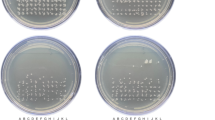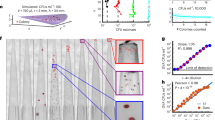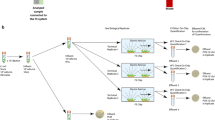Abstract
Mixtures of bacteria, Enterococcus faecalis (ATCC 29212), Streptococcus pyogenes (ATCC 19615), Streptococcus agalactiae (ATCC 13813), Streptococcus pneumoniae (ATCC 6303), and Staphylococcus aureus (ATCC 29213), were resolved into discrete electrophoretic bands using capillary zone electrophoresis (CZE). Bacteria remained viable (>90%) during the electrophoretic process. Analysis of peak separation indicates organisms were quantitatively resolved and recovered at greater than 98% purity. E. faecalis was resolved into two discrete fractions with different chain assemblages that may reflect different developmental stages. These findings suggest that CZE can afford the microbiologist a new tool for studying the composition and distribution of microorganisms in mixed populations.
This is a preview of subscription content, access via your institution
Access options
Subscribe to this journal
Receive 12 print issues and online access
$209.00 per year
only $17.42 per issue
Buy this article
- Purchase on Springer Link
- Instant access to full article PDF
Prices may be subject to local taxes which are calculated during checkout
Similar content being viewed by others
References
Shapiro, H.M. 1990. Flow cytometry in laboratory microbiology: New directions. ASM News 56: 584–588.
Shapiro, J.A. 1991. Multicellular behavior of bacteria. ASM News 57: 247–253.
Johnstone, K.I. 1969. The isolation and cultivation of single organisms. In: Methods in Microbiology, Vol 1. Norris, J. R. and Ribbons, D. W. (Eds.). Academic Press, Inc., New York, NY.
Veldkamp, H. 1970. Enrichment of prokaryotic organisms. In: Methods in Microbiology, Vol 3A. Norris, J. R. and Ribbons, D. W. (Eds.). Academic Press, Inc., New York, NY.
Herbert, R.A. 1990. Methods for Enumerating Microorganisms. In: Methods in Microbiology, Vol 22. Grigorva, R. and Norris, J. R. (Eds.). Academic Press, Inc., New York, NY.
Richmond, D.V. and Fisher, D.J. 1973. The electrophoretic mobility of microorganisms. Advances in Microbial Physiology 9: 1–29.
Uhlenbruck, G., Fröml, A., Lütticken, R. and Hannig, K. 1988. Cell electrophoresis of Group B streptococci before and after neuraminidase treatment. Zbl. Bakt. Hyg. A 270: 28–34.
Bauer, J. 1987. Electrophoretic separation of cells. J. Chromatogr. Biomed. Appl. 418: 359–383.
Lyklema, J. 1985. Interfacial electrochemistry of surfaces. In: Surface and Interfacial Aspects of Biomedical Polymers. Andrade, J. D. (Ed.). Plenum Press, New York, NY.
Lemp, J.F., Ausbury, E.D. and Ridenour, E.O. 1971. Electrophoresis of colloidal biological particles. Biotechnol. and Bioeng. 8: 17–41.
Bayer, M.E. and Sloyer, Jr. J.L. 1990. The electrophoretic mobility of Gram-positive and Gram-negative bacteria. J. General Microbio. 136: 867–874.
Grossman, P.D., Colburn, J.C. and Lauer, H.H. 1989. The electrophoretic mobility of peptides in free-solution capillary electrophoresis. Anal. Biochem. 179: 28–33.
Guttman, A., Cohen, A.S., Heiger, D.N. and Karger, B.L. 1990. Ultrahigh resolution of oligonucleotides by polyacrylamide gel high-performance capillary electrophoresis. Anal. Chem. 62: 137–141.
Hjertén, S., Elenbring, K., Kilar, F., Liao, J.L., Chen, A.J.C., Siebert, C.J. and Zhu, M.D. 1987. Carrier-free zone electrophoresis, displacement electrophoresis and isoelectric focusing in a high performance electrophoresis apparatus. J. Chromatogr. 403: 47–61.
Jones, H.K. and Ballou, N.E. 1990. Separation of chemically different particles by capillary electrophoresis. Anal. Chem. 62: 2484–2490.
Lauer, H.H. and McManigill, D. 1986. Capillary zone electrophoresis of proteins in fused silica tubing. Anal. Chem. 58: 166–170.
McCormick, R.M. 1991. Characterization of silica sols using capillary zone electrophoresis. J. Liq. Chromatog. 14: 939–952.
Van Orman, B.B. and McIntyre, G.L. 1989. Analytical separation of polystyrene microspheres by means of capillary electrophoresis. J. Microcolumn Separations 1: 289–293.
Zagursky, R.J. and McCormick, R.M. 1990. DNA sequencing separations in capillary gels. Biotechniques 9: 74–79.
Olivera, B.M., Baine, P. and Davidson, N. 1964. Electrophoresis of nucleic acids. Biopolymers 2: 245–257.
Higgins, M.L., Pooley, H.M. and Shockman, G.D. 1971. Reinitiation of Cell wall growth after threonine starvation of Streptococcus faecalis. J. Bacteriology 105: 1175–1183.
McCormick, R.M. 1988. Capillary electrophoretic separation of peptides and proteins using low pH buffers in modified silica capillaries. Anal. Chem. 60: 2322–2328.
Author information
Authors and Affiliations
Rights and permissions
About this article
Cite this article
Ebersole, R., McCormick, R. Separation and Isolation of Viable Bacteria by Capillary Zone Electrophoresis. Nat Biotechnol 11, 1278–1282 (1993). https://doi.org/10.1038/nbt1193-1278
Received:
Accepted:
Issue Date:
DOI: https://doi.org/10.1038/nbt1193-1278
This article is cited by
-
Optimized sample buffer for dispersed, high-resolution capillary zone electrophoretic separation of Escherichia coli B
Scientific Reports (2023)
-
Electrophoretic Determination of Lactococcus lactis Modified by Zinc Ions
Chromatographia (2019)
-
Assessment of the genetic polymorphism and physiological characterization of indigenous Oenococcus oeni strains isolated from Aglianico del Vulture red wine
Folia Microbiologica (2016)
-
Nano-capillary electrophoresis for environmental analysis
Environmental Chemistry Letters (2016)
-
Counter-pressure-assisted ITP with electrokinetic injection under field-amplified conditions for bacterial analysis
Analytical and Bioanalytical Chemistry (2015)



